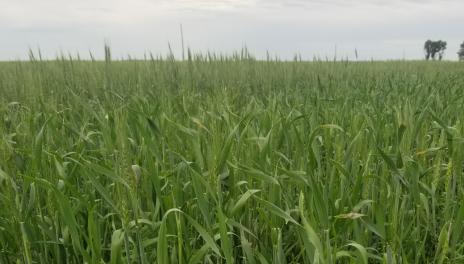Testing nitrogen fixing biologicals in spring wheat
This summer we tested two biological products that have symbiotic nitrogen fixing bacteria as their active ingredient: Envita by Azotic North America and Utrisha by Corteva Agriscience. The premise is that once you apply them to your crops, the microbes will work to fix nitrogen that the crops can use and in turn you can apply less nitrogen fertilizer than you otherwise would have to. The bacteria that are in these products form symbiosis with non-nodule forming plants such as wheat and corn. Rhizobia that infect soybean nodules need an anaerobic environment to fix nitrogen. The species in these products on the other hand thrive in oxygen-rich environments, therefore, nodules are not needed. They enter the plants through the tissues, stomata or root hairs. Once they infect the plant, they get carbohydrates from the plant in exchange for the nitrogen they fix, similar to legumes. Both bacterium species exist naturally in warmer climates but neither of them form spores, therefore they need a living host to survive and cannot endure our winters.
The trial with Utrisha and Envita was conducted at two locations: Carrington Research Extension Cener and North Central Research Extension Center at Minot. The products were foliar applied to spring wheat at the end of the tillering stage (Feekes 5) on plots that had nitrogen applied at the 0 or 60 lbs per acre rate as a starter. Additionally, there were plots that received 30, 90, 120 or 150 lbs of nitrogen per acre as a starter, in order to get a nitrogen yield response curve. All other nutrients were uniformly applied based on soil test. The biological treatments were mixed with chlorine-free water on the field, right before application.


Our results showed no significant yield increase from either Utrisha or Envita at either of the locations (Figures 1 and 2). However, it’s important to point out that at the Minot site there was no significant response to nitrogen fertilizer either. For this reason, it is not surprising that biological products which were meant to augment nitrogen uptake also did not have an effect at that location. At the Carrington site there was a weak nitrogen yield-response which plateaued at the 30 lbs N-rate. In light of this, the lack of response from biologicals at the 60 lbs N-rate is not surprising. However, Utrisha and Envita did not increase yield even when no nitrogen was applied.
We can not draw any long-standing conclusions based on these results. More site-years of data will be necessary to accurately judge the efficacy of these products. This article is merely an update of research that was conducted at the CREC and at the NCREC in Minot in cooperation with research agronomist Leandro Bortolon.
This research was funded by the North Dakota Wheat Commission.
NDSU Extension and the NDSU Agricultural Experiment State do not endorse commercial products or companies even though reference may be made to tradenames, trademarks or service names.
Szilvia Yuja
Szilvia.ZilahiSebess@ndsu.edu
Soils Research Specialist
